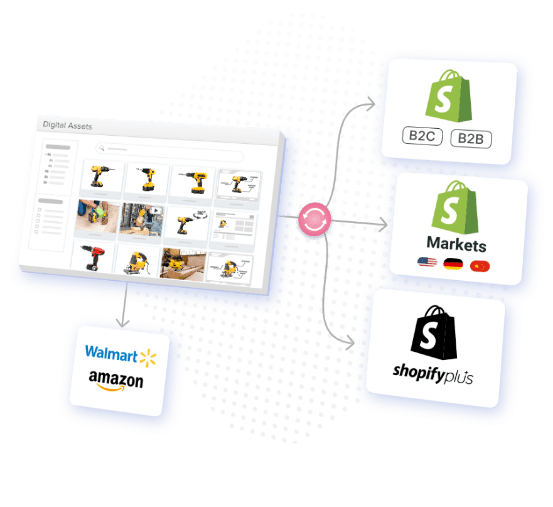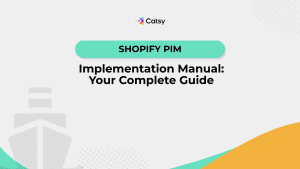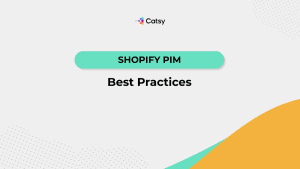How to Increase Shopify Conversion Rate: 5 Tactics with PIM & DAM

- Selling on multiple Shopify stores creates challenges with consistency and efficiency.
- The main problem lies in product content management, which undermines merchants' ability to sell as much as they should.
- Pairing Shopify with a unified PIM and DAM platform helps Shopify merchants boost conversion rates.
In this Article
Shopify is one of the most popular e-commerce software platforms worldwide. The latest usage statistics indicate that over 7.4 million online stores use Shopify as the backend. The platform claims a 10.32% market share worldwide, behind Squarespace, Woo Themes, and WooCommerce in first place. However, Shopify is the leading e-commerce software platform in the United States, with at least 28% of e-commerce stores using its technology for user interface, payment checkout, marketing tools, and hubs for fulfillment services.
Why is Shopify so popular? A Redditor posed this question in the e-commerce subreddit, “r/ecommerce,” and the comments were wide-ranging. However, one can conclude that Shopify derives its superpowers from the fact that it is easy to set up, even for non-technical users. One commenter said, “It’s popular because it is easy for newbies to set up. You can sell without having a coder on board, and there are lots of apps to add functionality.”
Merchants prefer Shopify because it is easy to use and allows one to scale the store quickly. Yet, some users encounter challenges. Not everyone meets the same challenges, but some are common. This article explores the most common challenges and shares five hacks to help you increase the chances of selling more products on Shopify.

The Most Common Challenges of Selling on Shopify
We know that ease of use is one of the most common reasons for choosing Shopify. This suggests that most online shops built on Shopify are retail businesses. That is, smaller businesses prefer ease of use because they do not carry the financial weight of large enterprises, which is necessary to utilize sophisticated features. In fact, a recent survey found that the average total revenue a Shopify merchant earns per shopper is $901, which suggests that most of the target buyers are individual consumers. But Shopify is also popular with business-to-business (B2B) merchants, thanks to the all-in-one platform.
Shopify users, regardless of the nature of the business, have one thing in common: they likely operate multiple stores. Unfortunately, and this is a common downside cited in forums and subreddits, Shopify does not natively support running multiple stores from one master account. For this reason, most of the challenges of selling on Shopify befall users with more than one storefront – this is also the focus of this discussion.
1. Data inconsistencies
If you cannot run one store for wholesale buyers and another separate entity for individual shoppers from one admin account, you should expect discrepancies in product detail pages (PDPs). This is not a rule, but something with a high probability of happening. The basis for this is that with numerous products and stores to manage, it’s easy for errors to slip in, leading to inconsistencies in product titles, product pages, descriptions, pricing, and images.
This challenge compounds when you manually update product information across the stores, which is tedious and time-consuming. Tired hands and exhausted brains will always make mistakes.
Add to that the fact that most products have variants, and your business grows over time, which increases the number of stores and product count. Inconsistencies can quickly spiral out of control, making it impossible to manage your stores effectively.
2. Image and asset management
Online shoppers are drawn to products with crisp and detailed images. Higher-quality images attract the most customers because they reassure them about the quality of the product they wish to buy.
Search engines, too, have a thing for high-quality product photos. According to a DeepImage analysis, high-quality images significantly contribute to search engine ranking – algorithms prioritize product photos that meet (or exceed) quality metrics. Some analytics include metadata optimization, loading speed, and mobile optimization.
The problem is that managing these assets across multiple stores can be backbreaking. For example, let’s say you sell a product in various colors, and you want to showcase each color option with high-quality images on each of your Shopify stores. If you’re managing these images manually, you may need to upload and organize them separately for each store, which can be tedious and time-consuming.
Accuracy and currency issues also arise when managing product images. If you update a product image on one store but forget to update it on another, the result is inconsistencies and customer confusion. Similarly, if you discontinue a product or change its features, you may need to update all associated visual assets to ensure accuracy.
3. Inventory synchronization
The Shopify app store provides plenty of options for streamlining various aspects of inventory control. For instance, you can get apps that offer real-time tracking of inventory levels across multiple locations, automated procurement processes, and the ability to easily adjust inventory levels for products and variants directly from the Shopify admin.
The problem is that these conveniences are only available within one store. You cannot, for example, make simultaneous inventory level adjustments in the US-based store and your other store serving Latin America. In other words, there isn’t a way to synchronize inventory across multiple stores. You’d have to do it store-by-store, which is repetitive and demanding, especially when dealing with many products and variants.
When inventory levels are not accurately synchronized across all stores, it can lead to overselling. Overselling happens when you accept orders for products that are out of stock. This leads to disappointed customers, potential cancellations, and a negative impact on your reputation.
4. Marketing and customization
Competition is high in e-commerce; everyone works hard to become the shopper’s favorite. There are many approaches to standing out, but most businesses choose marketing and ads. According to estimates by the Small Business Association, a typical e-commerce business spends about 30% of its total income on marketing. This is against a recommendation of between 7% and 8%.
So, marketing is an essential aspect of business operations. But there is a problem. If you can’t manage your multiple stores from one Shopify admin account, you must run separate marketing campaigns for each store. This includes customizing the product information in each store to suit the target audience. You can imagine the numerous hours a team will have to burn to customize three stores (each serving a specific country) and create a unique marketing campaign.
Even if the team pulls off a miracle, there is a small matter of consistency across all stores. Customers expect a consistent brand experience, regardless of the store where they shop. This requires maintaining consistent branding, messaging, and design elements across all stores, which can be challenging.

The Challenges Negatively Impact Shopify Conversion Rates, Sales, and Overall Customer Experience
The challenges we’ve discussed don’t just create operational headaches; they directly undermine your bottom line. For instance, the frustration that arises from data inconsistencies leads to customers abandoning their carts or choosing a competitor with more precise product information.
Conversion rates suffer when your product images are grainy. Indiscernible images make customers hesitant to make a purchase. Also, you can’t convert shoppers who are browsing for a particular product if you use generic marketing techniques. Each customer base has specific needs, and merchants who meet them win the day. For example, if you try to sell hiking boots to someone who’s clearly looking for a power saw – you’re wasting everyone’s time and ultimately missing out on sales.
Furthermore, you might lose plenty of sales if you fail to synchronize inventory adequately. The negative reviews that follow frustrated customer encounters will also tarnish your reputation for a long time. If you’re not careful, Shopify may delist your shop if the negativity in the feedback section breaches a specific limit.
So, How to Improve and Increase Conversion Rates
The solution to Manage your product content better.
The upside is that these challenges are solvable. As you may have noticed, most, if not all, of these challenges stem from issues with product information and digital asset management. Therefore, one can conclude that if you can optimize product information and digital asset management, then selling more products to website visitors on Shopify won’t be an issue for your business ever again.
The secret to improve average conversion rates is to create a robust product data management strategy. This strategy must be built on robust product information management (PIM) and digital asset management software.
PIM and DAM consolidate product content into a centralized hub and allow you to enrich them. Specifically, PIM software sits between the product details in your inventory management system and the customer. It enriches the details to make them legible to customers. On the other hand, DAM software organizes digital assets related to your products.
Together, PIM and DAM offer much more than organizing and managing product information and digital assets. The best way to appreciate their robustness is to see them in action. Here are five hacks that demonstrate the prowess of PIM and DAM when it comes to improving conversion rates.
5 Conversion-Boosting Hacks with PIM & DAM
1. Create compelling product descriptions
Shopify allows you to create new products and display the information on your store’s PDP. For a merchant with only one store and a handful of products, this process is straightforward and devoid of challenges.
However, for merchants with many products, and each product with several variants, entering the details into the store can be demanding. Now, imagine the trouble you will encounter if you run five stores across different geographies.
Given the hard work required to do the job, you might end up only listing features. But this won’t cut it in a competitive e-commerce landscape.
Suppose you are shopping for a drill and come across the following description: Drill Machine – 850W, Variable Speed. This copy is too basic and lacks the details that should help to convince anyone to purchase.
However, this is the best you can do when you are short of time, and you must ensure that the details are up on the PDP as soon as possible. A PIM is a lifesaver in this situation.
A PIM tool solves repetitive and highly manual tasks like creating product details. You can create the details manually within the platform or pull them from inventory management systems. This tool can transform the basic details that won’t catch anyone’s attention into an unmissable copy.
2. Optimize product images & videos
As part of creating products in your Shopify catalog, you can upload images for display on the PDP. Shopify demands that all photos meet specific requirements. For instance, images must be 20 megapixels, 2048 x 2048 pixels for square photos, 20 megabytes of maximum image file size, and images must be at least 800 x 800 pixels for proper zoom functionality.
While you can apply the requirements to each product photo uploaded, it is energy-sapping to do this for hundreds of images one by one. The resulting fatigue may lead to uploading unrelated images.
A DAM is handy in this situation. This software consolidates all images related to your products into a repository, so you don’t have to maintain a library scattered across cloud and physical drives.
Beyond organization, a DAM allows you to optimize product images to meet Shopify’s standards. The good thing about this functionality is that it will enable you to edit the photos in bulk. For example, Catsy’s DAM can resize multiple images simultaneously to the ideal dimensions for your Shopify stores. Also, the tool helps to generate descriptive alt text and metadata, improving search engine optimization (SEO) and accessibility for visually impaired shoppers.
Like product details, you only edit the product images once in DAM and propagate them to all connected Shopify stores. So, a DAM expedites product image optimization and makes the process very efficient.
3. Command center for multiple Shopify stores
Throughout this article, we have pointed out how merchants’ inability to operate multiple storefronts from a master account is one of Shopify’s most significant downsides. What if it is possible to enjoy Shopify’s functionalities and deep ecosystem while circumventing this downside?
The essence of centrally managed Shopify stores is to be able to do something once (such as updating descriptions) and then propagate to all live stores. In this case, the probability of errors (either human or otherwise) is close to none. Fortunately, it is possible to create such a platform using PIM and DAM. The platform will work best if PIM and DAM are closely integrated into a unified software solution.
A unified PIM and DAM is a software platform that combines the functionalities of a PIM and DAM. You can manage product information and digital assets inside one window without opening a separate software. One example of such a system is Catsy.
We explained earlier that Catsy has a specialized API for Shopify integration, hence the phrase Shopify PIM. This API allows users to connect up to five Shopify stores and be able to operate them simultaneously. Catsy connects separate Shopify stores, enabling seamless operation despite Shopify’s single-store setup. This means that even though Shopify only allows one store per account, Catsy can link multiple Shopify stores (and accounts) under the same email address.
The unified platform centralizes all product content for the products to be listed in the stores. So, you’ll make changes within the unified platform and then propagate them to each store. Most crucially, you can customize the content to meet each store’s requirements.
4. Expedite product launches and updates
The digital marketplace is a competitive environment and those stores that cannot withstand the pressure to perform shut down. In fact, some estimates say that four out of every five e-commerce startups fail to take off. This reality should worry you, especially considering the average business failure rate in the broad technology space is 63%. In other words, the e-commerce landscape favors dynamic businesses.
One of the best manifestations of dynamism is to launch new products faster and update existing ones before anyone else does it. Unfortunately, this is a tall order if you run multiple stores and have no means to automate processes like product listings.
However, you are in luck if you can access a unified PIM and DAM platform like Catsy. As explained earlier, the platform can be a command center where all product data-related activities happen. For example, Catsy allows you to automate the creation and updating of product listings. The kicker is that you do all the work in the unified platform and then quickly push the data to all connected stores.
5. Implementing dynamic pricing
Dynamic pricing lets you adjust prices strategically based on real-time market conditions – a powerful tool to sell more on Shopify. However, the real-time aspect of this strategy means that you need speedy hands and possibly a dedicated employee for each store. Nevertheless, this approach won’t maximize the potential of dynamic pricing.
PIM software provides the capabilities to make the best of a dynamic pricing strategy. The tool creates a firm backbone to make this work smoothly across all your Shopify stores. But how?
A PIM like Catsy centralizes and updates inventory levels as soon as they change in the inventory management system. This real-time data on product availability feeds directly into your Shopify store’s dynamic pricing strategy, allowing for immediate adjustments based on supply and demand.
The PIM also ensures that dynamic pricing is consistent across all your stores. This is crucial for maintaining customer trust and brand integrity. Any inconsistencies can be frustrating to shoppers.
The result? PIM-powered dynamic pricing generates several advantages:
- Maximize profits: You optimize prices in response to fluctuations, avoiding stockouts or missing out on potential revenue from increased demand.
- Enhanced brand trust: Consistent pricing reinforces fairness and reliability, fostering customer loyalty.
- Data-driven decisions: Base your pricing strategy on concrete data, not guesswork.

Increase Your Conversion Rates with Catsy PIM & DAM
Shopify’s popularity is a testament to its ease of use and scalability. But just like any powerful tool, Shopify reaches its full potential when paired with the right complementary solutions for conversion rate optimization.
Many robust software platforms are available, each designed to excel at specific tasks. For e-commerce businesses managing multiple Shopify stores, PIM and DAM are the perfect partners. They streamline operations, eliminate errors, and allow you to deliver a superior customer experience across all your stores.
Even better, consider a unified PIM and DAM platform. These combine the functionalities of both systems, offering a seamless workflow and enhanced data management capabilities.
Look at it this way: Shopify is a launchpad for your e-commerce success, but PIM and DAM are the rocket fuel that propels you toward a thriving online business.
Product Information Management (PIM) and Digital Asset Management (DAM) are software platforms that help businesses manage their product content. The main difference between the two is the type of content they focus on. PIM primarily manages product-related information, such as descriptions, specifications, and pricing. DAM, on the other hand, is used to manage a broader range of digital assets, such as images, videos, and marketing materials.
Yes, PIM and DAM can be integrated with your existing Shopify store. Many PIM and DAM providers offer pre-built integrations with Shopify, making it easy to connect the platforms and start managing your product information and digital assets more effectively. For example, Catsy’s robust API connection allows you to manage product content for up to five Shopify stores.
PIM and DAM can improve the customer experience on Shopify in several ways. Businesses can use PIM to create compelling product descriptions and DAM to optimize product images and videos to provide customers with a more engaging and informative shopping experience. Additionally, the tools help businesses ensure that product information and digital assets are consistent and up-to-date across all their Shopify stores, reducing confusion and improving customer trust.
A unified PIM and DAM platform combines the functionality of both PIM and DAM into a single software solution. The main benefit of using a unified platform is that it provides businesses with a centralized hub for managing all their product-related information and digital assets. This can improve efficiency, reduce errors, and make it easier to maintain consistency and accuracy across all channels.
Absolutely. While this article focused on the benefits for Shopify merchants, most vendors of PIM and DAM systems design them to integrate with various e-commerce platforms and sales channels. For example, Catsy’s unified PIM and DAM platform has pre-built connections with BigCommerce and Magento, retailers like Amazon and Walmart, and distributors like Ferguson and Google Manufacturer Center.




